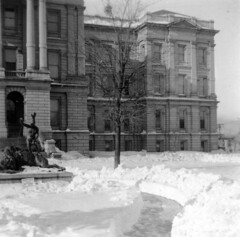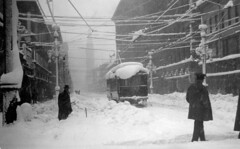
Significant snow events in Colorado are not unusual however some are nothing short of epic. Such was the case with the Great Colorado Snowstorm of 1913, a storm that occurred 110 years ago today and still stands as the largest snow event in Denver history.
It was a classic setup. Low pressure to Colorado’s southwest slowly moved to the northeast drawing in moist air – and dropping snow along the Front Range.
The first three days of the storm were relatively calm with Denver only seeing 8 inches. On the 4th and 5th however Mother Nature let loose with 37.4 inches of snow.
- Scroll down to view some photos from the monstrous storm
- National Weather Service Poster about the 1913 Snowstorm (PDF)
The total for the event, 45.7 inches, was and still is the heaviest single snowfall event in Denver history. To the west, Georgetown recorded an even more amazing 86 inches, 63 of which fell on the 4th of the month alone.
The Denver Post headline on December 5, 1913 read, “Denver in Mantle of Shimmering White, Stops Activity and Everybody Jollifies.”
A subheading said, “All Denver is Waking Amid Ghostly Silence of Streets That Are Buried – Whole State Fells Storm of Varying Intensity.”
The Post’s now defunct competitor, the Rocky Mountain News, saw a silver lining. Its headline read, “Colorado Gripped by Worst Snowstorm Recorded in 28 Years; Denver is Hit Hard, but Blizzard Means Millions in Crops.”
Indeed, in a day long before four wheel drive existed and when horse and carriage were as common as cars, the storm had a tremendous impact.
Travel was brought to a complete halt in the area as snow drifts blocked all roads. Trolleys were unable to run downtown and railroads in and out of the city were stopped. It would be a week before streetcar service was returned to normal.
Stranded workers were housed at the city auditorium, jail and movie theatres. Telegraph, telephone and electrical service were interrupted as the snow downed lines across the area. Schools were closed at the height of the storm and some remained shuttered for days.
Any open space in the city became a snow dumping ground as the city dug out. The Rocky Mountain News reported that anyone needing work could help the Tramway company with snow removal. Pay was $3.50 per day.
Despite the ferocity of the storm, accounts of the day indicate only a few fatalities. Dozens of buildings did collapse under the sheer weight of the snow.
The Great Colorado Snowstorm coupled with smaller events over the rest of the month yielded a snowfall total for December 1913 of 57.4 inches, the snowiest month ever recorded in Denver. Additionally, 5.21 inches of precipitation was recorded making the month the wettest December on record.















 Performing prescribed burns is an important way to clear brush and renew wildland and are often done without any excitement. Mother Nature had other plans last week however as whirling winds propelled a fire beyond its containment lines at the Rocky Mountain Arsenal National Wildlife Refuge.
Performing prescribed burns is an important way to clear brush and renew wildland and are often done without any excitement. Mother Nature had other plans last week however as whirling winds propelled a fire beyond its containment lines at the Rocky Mountain Arsenal National Wildlife Refuge. A magnitude 4.4 earthquake struck the Los Angeles area Monday morning in the pre-dawn hours. While a relatively minor quake, it was strong enough to rattling residents and send morning TV news anchors under their desks.
A magnitude 4.4 earthquake struck the Los Angeles area Monday morning in the pre-dawn hours. While a relatively minor quake, it was strong enough to rattling residents and send morning TV news anchors under their desks. Icy roads Saturday morning led to a massive 104 car pileup on Interstate 25 through central Denver killing one person and injuring 30.
Icy roads Saturday morning led to a massive 104 car pileup on Interstate 25 through central Denver killing one person and injuring 30. With a large, cold air mass settled in across much of the nation’s midsection, weather records are bound to fall. In the Mile High City the record for coldest high temperature for the date was not just broken but smashed.
With a large, cold air mass settled in across much of the nation’s midsection, weather records are bound to fall. In the Mile High City the record for coldest high temperature for the date was not just broken but smashed.